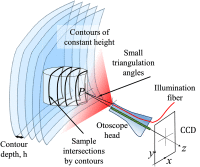Combined high-speed holographic shape and full-field displacement measurements of tympanic membrane
- PMID: 30255670
- PMCID: PMC6444583
- DOI: 10.1117/1.JBO.24.3.031008
Combined high-speed holographic shape and full-field displacement measurements of tympanic membrane
Abstract
The conical shape of the tympanic membrane (TM or eardrum) plays an important role in its function, such that variations in shape alter the acoustically induced motions of the TM. We present a method that precisely determines both shape and acoustically induced transient response of the entire TM using the same optics and maintaining the same coordinate system, where the TM transient displacements due to a broadband acoustic click excitation (50-μs impulse) and the shape are consecutively measured within <200 ms. Interferograms gathered with continuous high-speed (>2 kHz) optical phase sampling during a single 100-ms wavelength tuning ramp allow precise and rapid reconstructions of the TM shape at varied resolutions (50 to 200 μm). This rapid acquisition of full-field displacements and shape is immune to slow disturbances introduced by breathing or heartbeat of live subjects. Knowledge of TM shape and displacements enables the estimation of surface normal displacements regardless of the orientation of the TM within the measurement system. The proposed method helps better define TM mechanics and provides TM structure and function information useful for the diagnosis of ear disease.
Keywords: high-speed holography; middle ear; shape and displacement measurement; tympanic membrane.
Figures
















Similar articles
-
Motion of the surface of the human tympanic membrane measured with stroboscopic holography.Hear Res. 2010 May;263(1-2):66-77. doi: 10.1016/j.heares.2009.12.024. Epub 2009 Dec 23. Hear Res. 2010. PMID: 20034549 Free PMC article.
-
Three-dimensional vibrometry of the human eardrum with stroboscopic lensless digital holography.J Biomed Opt. 2015 May;20(5):051028. doi: 10.1117/1.JBO.20.5.051028. J Biomed Opt. 2015. PMID: 25652791 Free PMC article.
-
Full-field transient vibrometry of the human tympanic membrane by local phase correlation and high-speed holography.J Biomed Opt. 2014 Sep;19(9):96001. doi: 10.1117/1.JBO.19.9.096001. J Biomed Opt. 2014. PMID: 25191832 Free PMC article.
-
Analyses of the Tympanic Membrane Impulse Response Measured with High-Speed Holography.Hear Res. 2021 Oct;410:108335. doi: 10.1016/j.heares.2021.108335. Epub 2021 Aug 11. Hear Res. 2021. PMID: 34450569 Free PMC article.
-
Human middle-ear muscle pulls change tympanic-membrane shape and low-frequency middle-ear transmission magnitudes and delays.Hear Res. 2023 Mar 15;430:108721. doi: 10.1016/j.heares.2023.108721. Epub 2023 Feb 11. Hear Res. 2023. PMID: 36821982 Review.
Cited by
-
Multiple angle digital holography for the shape measurement of the unpainted tympanic membrane.Opt Express. 2020 Aug 17;28(17):24614-24628. doi: 10.1364/OE.398919. Opt Express. 2020. PMID: 32907000 Free PMC article.
-
High-Speed Holographic Shape and Full-Field Displacement Measurements of the Tympanic Membrane in Normal and Experimentally Simulated Pathological Ears.Appl Sci (Basel). 2019 Jul 2;9(14):2809. doi: 10.3390/app9142809. Epub 2019 Jul 13. Appl Sci (Basel). 2019. PMID: 32802482 Free PMC article.
-
Randomized Comparison of Endoscopic Cartilage-Perichondrium Sandwich Technique Verses Underlay Technique for Large Tympanic Membrane Perforations.J Otolaryngol Head Neck Surg. 2025 Jan-Dec;54:19160216251333748. doi: 10.1177/19160216251333748. Epub 2025 Apr 22. J Otolaryngol Head Neck Surg. 2025. PMID: 40259768 Free PMC article. Clinical Trial.
-
Comparison of healing of acute total tympanic membrane perforation between rats with and without excision of the mallear handle.Laryngoscope Investig Otolaryngol. 2023 Oct 26;8(6):1648-1656. doi: 10.1002/lio2.1175. eCollection 2023 Dec. Laryngoscope Investig Otolaryngol. 2023. PMID: 38130269 Free PMC article.
-
Contemporary Mechanics of Conductive Hearing Loss.Oper Tech Otolayngol Head Neck Surg. 2024 Mar;35(1):2-10. doi: 10.1016/j.otot.2024.01.001. Epub 2024 Jan 17. Oper Tech Otolayngol Head Neck Surg. 2024. PMID: 38680732 Free PMC article.
References
-
- Geisler C. D., From Sound to Synapse: Physiology of the Mammalian Ear, Oxford University Press, Oxford: (1998).
-
- Rosowski J. J., “Outer and middle ears,” in Comparative Hearing: Mammals, Fay R. R., Popper A. N., Eds., pp. 172–247, Springer, New York: (1994).
Publication types
MeSH terms
Grants and funding
LinkOut - more resources
Full Text Sources
Other Literature Sources

